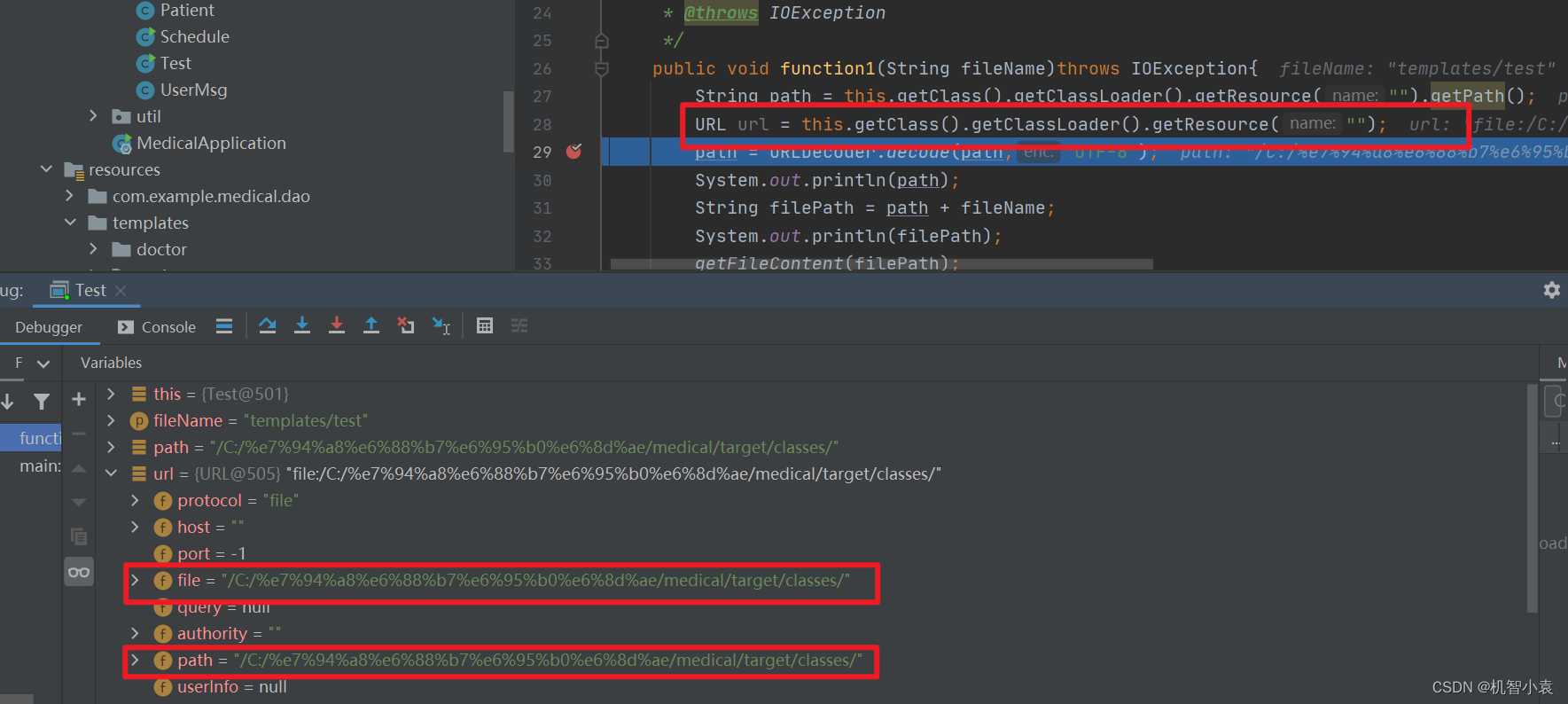各种读取resources目录下文件的方法
引言
我们写使用java写web项目时,有时需要将某些文件存放到resources目录下,之后我们需要在程序中去获取文件。此时就有一个重要的事情:如何获取文件的路径?
下面我将给出八种获取resources的方式。
注意:有的可以在web项目中使用,有的则不可以在web项目中使用。
读取展示文件的工具方法
首先给出读取展示 文件的代码块:
/**
* 需要有明确路径,因为需要输出显示,所以最好是文本文档:“.txt”、“.html”、“.js”等
* @param fileInPath
* @throws IOException
*/
public static void getFileContent(Object fileInPath) throws IOException {
BufferedReader br = null;
if (fileInPath == null) {
return;
}
if (fileInPath instanceof String) {
//如果是字符串路径
br = new BufferedReader(new FileReader(new File((String) fileInPath)));
} else if (fileInPath instanceof InputStream) {
//如果是输入流
br = new BufferedReader(new InputStreamReader((InputStream) fileInPath));
}
String line;
while ((line = br.readLine()) != null) {
System.out.println(line);
}
br.close();
}
先获取路径再去获取文件
准备:getFile() getPath()须知
我们使用:
this.getClass().getClassLoader().getResource("").[getPath()/getFile()];
这个命令去获取resource的路径,下面我打断点,可以看到resource的内容,里面有file,path。

如果是文件路径的话getFile和getPath效果是一样的,如果是URL路径的话getFile是带有参数的路径。
例如:

getResource(“”).getPath()获取resource路径
/**
* 读取resources下的文件,getResource("")然后拼接
* @param fileName
* @throws IOException
*/
public void function1(String fileName)throws IOException{
String path = this.getClass().getClassLoader().getResource("").getPath();
path = URLDecoder.decode(path,"UTF-8");
System.out.println(path);
String filePath = path + fileName;
System.out.println(filePath);
getFileContent(filePath);
}
getResource(fileName).getPath()直接获取完整路径
/**
* getResource(fileName)直接获取完整路径
* @param fileName
* @throws IOException
*/
public void function2(String fileName)throws IOException{
String path = this.getClass().getClassLoader().getResource(fileName).getPath();
System.out.println(path);
String filePath = URLDecoder.decode(path,"UTF-8");
System.out.println(filePath);
getFileContent(filePath);
}
getResource(fileName).getFile()获取完整路径
/**
* getFile()
* @param fileName
* @throws IOException
*/
public void function3(String fileName)throws IOException{
String path = this.getClass().getClassLoader().getResource(fileName).getFile();
System.out.println(path);
String filePath = URLDecoder.decode(path,"UTF-8");
System.out.println(filePath);
getFileContent(filePath);
}
System.getProperty(“user.dir”)(不能在web应用使用)
/**
* user.dir默认会定位到你的工程根目录,但是web项目不行如果是web项目会定位到tomcat的bin目录
* @param fileName
* @throws IOException
*/
public void function7(String fileName)throws IOException{
String rootPath = System.getProperty("user.dir");
String filePath = rootPath+"/src/main/resources/"+fileName;
getFileContent(filePath);
}
getCanonicalPath();getAbsolutePath()
/**
* 不能在web应用中使用。
* @param fileName
* @throws IOException
*/
public void function8(String fileName)throws IOException{
File directory = new File("");
//规范路径:getCanonicalPath()方法返回绝对路径
String rootCanonicalPath = directory.getCanonicalPath();
//绝对路径:getAbsolutePath()方法返回文件的绝对路径,如果创建的时候使用的绝对路径返回绝对路径,创建的时候使用的相对路径,返回相对路径
String rootAbsolutePath = directory.getAbsolutePath();
System.out.println(rootCanonicalPath);
System.out.println(rootAbsolutePath);
String filePath = rootCanonicalPath+"/src/main/resources/"+fileName;
getFileContent(filePath);
}
直接去获取流
现在主流的部署方式是将项目打成jar包部署。而在jar包中是没有路径的,因为系统会认为jar包是个文件。所以我们就要通过流的方式去获取文件。
getResourceAsStream获取流
/**
* 直接获取流数据
* @param fileName
* @throws IOException
*/
public void function(String fileName)throws IOException{
InputStream in = this.getClass().getClassLoader().getResourceAsStream(fileName);
getFileContent(in);
}
不使用getClassLoader获取流
/**
* 不使用getClassLoader,直接获取resources下的文件。需要前面添加”/“
* @param fileName
* @throws IOException
*/
public void function(String fileName)throws IOException{
InputStream in = this.getClass().getResourceAsStream("/"+fileName);
getFileContent(in);
}
ClassPathResource类获取流
/**
* 通过ClassPathResource类获取,建议SpringBoot中使用
* @param fileName
* @throws IOException
*/
public void function6(String fileName)throws IOException{
ClassPathResource classPathResource = new ClassPathResource(fileName);
InputStream in = classPathResource.getInputStream();
getFileContent(in);
}






















 2905
2905











 被折叠的 条评论
为什么被折叠?
被折叠的 条评论
为什么被折叠?








